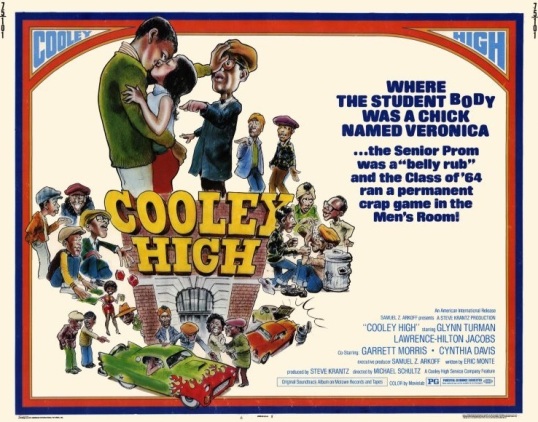For our next entry in Back to School, we take a look at a film that is often referred to as being a “black American Graffiti,” 1975’s Cooley High.
Cooley High follows the adventures of two lifelong friends who are both seniors at Edwin G. Cooley Vocational High School in Chicago, Illinois. The charismatic Cochise (Lawrence Hilton-Jacobs) is a popular and friendly basketball star. Meanwhile, Preach (Glynn Turman) is an aspiring writer who, despite his obvious intelligence, is also one of the worst students at the school. Preach divides his time between skipping school, gambling, and writing poetry. Alone among their friends, Cochise and Preach both seem to have a chance to escape from life in the projects. At the start of the film, Cochise has just received a scholarship to play basketball in college. As for Preach, he’s the eternal optimist. He knows he’s going to make it, even if he doesn’t seem to be quite sure how he’s going to do it.
For the first half of the film, Cooley High is largely a plotless collection of vignettes featuring Cochise, Preach, and their friends skipping school, chasing girls, getting into minor trouble, and trying to avoid major trouble. The emphasis is on comedy but, unlike a lot of high school comedies from the 70s and 80s, the humor grows organically from the characters. Facing a future that’s likely to be dominated by prejudice, poverty, and limited opportunity, what can the students of Cooley High do other than laugh? The second half of the film takes a far more dramatic turn, with Preach and Cochise accused of both stealing a car and snitching on the actual thieves in order to get out of jail. The film’s downbeat conclusion may be predictable but it’s effective all the same.
One reason why I wanted to review Cooley High is because a few months ago, while I was trying to find something to watch on TV, I came across an episode of a show called Unsung Hollywood. The title of the episode was “The Story of Cooley High” and it told the story of how and why this film was made. It was actually pretty interesting to watch, as it featured interviews with screenwriter Eric Monte (who based the character of Preach on himself), director Michael Schultz (who directed a lot of memorable films in the 70s — including Sgt. Pepper’s Lonely Hearts Club Band — but has never quite gotten the recognition that he deserves), and the film’s two stars. Even more interesting, however, were the interviews with the local Chicago residents who essentially played themselves during the filming of Cooley High. Some of them had fond memories of appearing in the film while others were upset that the film’s box office success didn’t open up any new opportunities for them. Most haunting of all was the fate of an amateur local named Norman Gibson. After giving a genuinely good performance as a petty criminal who comes to a violent end in Cooley High, Gibson was murdered a year after the film was released.
As I mentioned before, Cooley High is often compared to American Graffiti and the two films do have some things in common, like the period setting and a great soundtrack. Ultimately, though, Cooley High can stand on its own.
